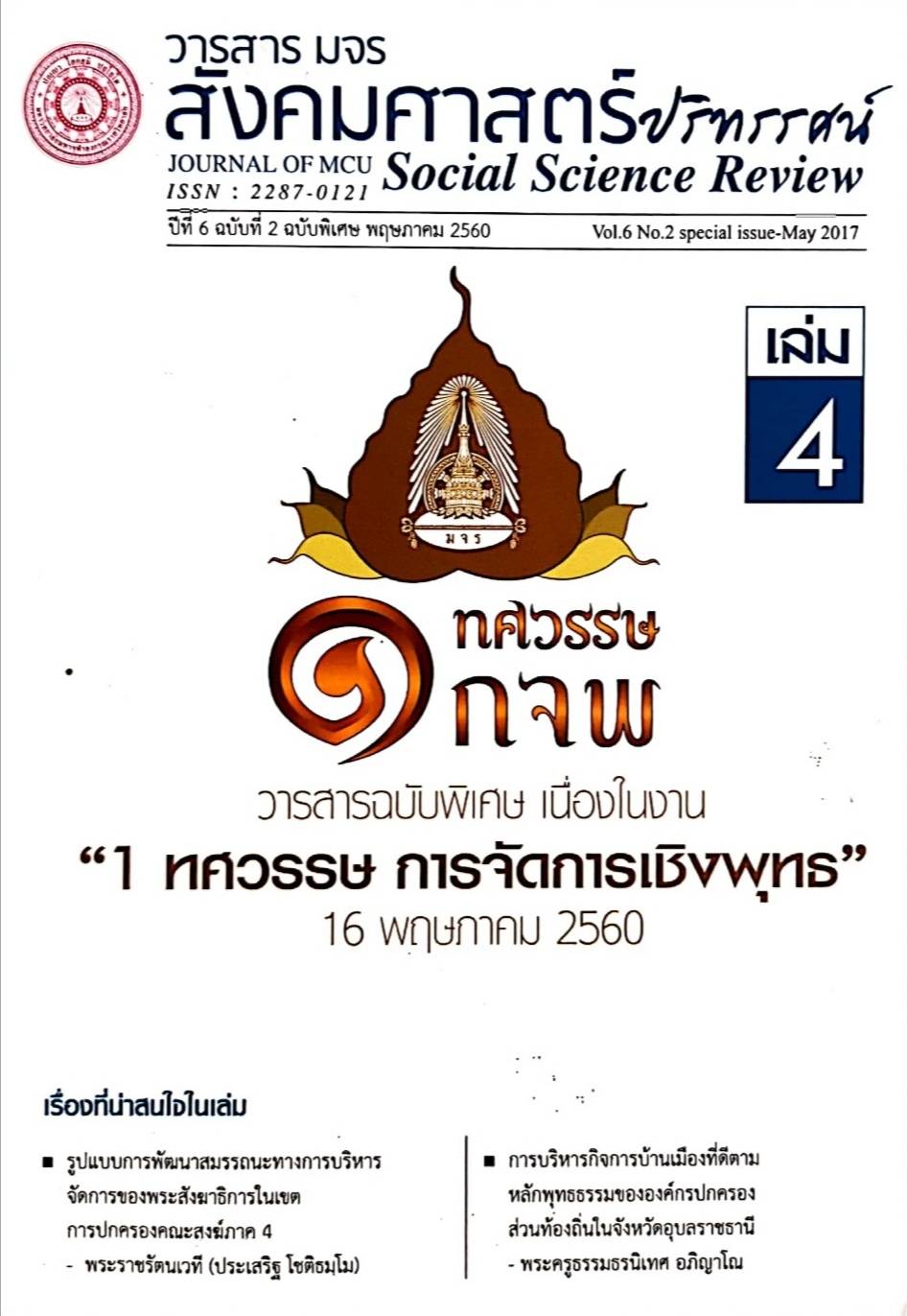พัฒนาการการศึกษาพระปริยัติธรรมแผนกธรรมในจังหวัดเชียงใหม่
คำสำคัญ:
การศึกษา; พระปริยัติธรรม; แผนกธรรมบทคัดย่อ
บทความนี้ เป็นส่วนหนึ่งของสารนิพนธ์เรื่อง “พัฒนาการการศึกษาพระปริยัติธรรม
แผนกธรรมในจังหวัดเชียงใหม่” มีวัตถุประสงค์ (1) เพื่อศึกษากาเนิดและพัฒนาการของการศึกษา
พระปริยัติธรรมแผนกธรรมในประเทศไทย (2) เพื่อศึกษากาเนิดและพัฒนาการของการศึกษาพระ
ปริยัติธรรมแผนกธรรมในจังหวัดเชียงใหม่ พบว่า พระปริยัติธรรมมีมาตั้งแต่สมัยสุโขทัยถึง
รัตนโกสินทร์ สมัยรัชกาลที่ 1-4 ได้เตรียมการเพื่อปฏิรูปการศึกษา ในรัชกาลที่ 5 ได้มีการพัฒนา
รูปแบบและหลักสูตร มีการตั้งสานักเรียนและสอบไล่ทุกปี ตั้งแต่ พ.ศ. 2432 ก็เริ่มมีระบบแบบแผน
ที่ชัดเจน ในรัชกาลที่ 6 การศึกษาของฝุายบ้านก็แยกออกวัด ทาให้สงฆ์ต้องยกระดับการศึกษา
นาไปสู่การจัดการศึกษารูปแบบใหม่เรียกว่าพระปริยัติธรรมแผนกธรรมขึ้นใน พ.ศ. 2454 ส่วน
จังหวัดเชียงใหม่ คือ ตั้งแต่สมัยพญามังรายถึงพญาผายู การศึกษาพระปริยัติธรรมยังไม่มีรูปแบบ
ชัดเจน สมัยพญากือนาถึงพระเมืองแก้วได้ถือตามลังกา เมื่อรวมกับสยามอย่างเป็นทางการใน พ.ศ.
2417 การศึกษาที่เป็นระบบก็ยังไม่มี พ.ศ.2442 เริ่มมีการขยายการศึกษาไปยังหัวเมือง ฝุายจัด
การศึกษาได้มาตั้งโรงเรียนที่วัดเจดีย์หลวงและจัดสอบ มีครูคือพระสงฆ์ หลักสูตรประกอบด้วยวิชาที่
เรียน ทั้งเชิงปฏิบัติและวิชาชีพพิเศษ อันเป็นไปตามนโยบายของภาครัฐและหลักสูตรนักธรรมและ
ธรรมศึกษาของคณะสงฆ์ไทยจากส่วนกลาง
เอกสารอ้างอิง
กรุงเทพมหานคร: โรงพิมพ์การศาสนา.
กรมการศาสนา. (2530). คู่มือการจัดการศึกษาพระปริยัติธรรม. กรุงเทพมหานคร: โรงพิมพ์การ
ศาสนา.
กรมการศาสนา. (2527). ประวัติการศึกษาของคณะสงฆ์. กรุงเทพมหานคร: โรงพิมพ์การศาสนา.
เฉลิมพล โสมอินทร์. (2546).ประวัติศาสตร์และพระพุทธศาสนาและการปกครองคณะสงฆ์ไทย.
กรุงเทพมหานคร: สานักพิมพ์สูตรไพศาล.
ชาย โพธิสิตา. (2522). มหาวิทยาลัยสงฆ์ในสังคมไทย: การศึกษาบทบาทของมหาจุฬาลงกรณราช
วิทยาลัย. กรุงเทพมหานคร: โรงพิมพ์มหาจุฬาบรรณาคาร.
ปริญญา กายสิทธิ์. (2528). “ประวัติศาสตร์พระพุทธศาสนาในล้านนาไทยตั้งแต่ พ.ศ. 1912 ถึง
พ.ศ. 2010”. วิทยานิพนธ์การศึกษามหาบัณฑิต. บัณฑิตวิทยาลัย: มหาวิทยาลัยศรีนคริ
นทรวิโรฒประสานมิตร.
พระบาทสมเด็จพระจุลจอมเกล้าเจ้าอยู่หัว. (2510). พระราชดารัสในพระบาทสมเด็จพระ
จุลจอมเกล้าเจ้าอยู่หัว ตั้งแต่ พ.ศ. 2417-2453. พระนคร: โรงพิมพ์สถานสงเคราะห์หญิง
ปากเกร็ด.
พระปลัดสนชัย ภูมิปาโล (หามนตรี). (2554). “ประสิทธิภาพการจัดการศึกษาโรงเรียนพระปริยัติ
ธรรม แผนกธรรมศึกษา ในอาเภอภาชี จังหวัดพระนครศรีอยุธยา”. วิทยานิพนธ์พุทธ
ศาสตรมหาบัณฑิต. บัณฑิตวิทยาลัย: มหาวิทยาลัยมหาจุฬาลงกรณราชวิทยาลัย.
พระปัญญาสามี. (2506). ศาสนวงศ์หรือประวัติศาสนา. แปลโดย ศาสตราจารย์ ร.ต.ท.แสง มน
วิทูร.กรุงเทพมหานคร: รุ่งเรืองธรรม.
มหาจุฬาลงกรณราชวิทยาลัย. (2539).พระไตรปิฎกภาษาไทย ฉบับมหาจุฬาลงกรณราชวิทยาลัย.
กรุงเทพมหานคร:โรงพิมพ์มหาจุฬาลงกรณราชวิทยาลัย .
สวัสดิ์ เขมกปสิทธิ. (2531).ประวัติศาสตร์พระพุทธศาสนาในประเทศไทย. เชียงใหม่: ลานนาการ
พิมพ์.
สิริวัฒน์ คาวันสา.(2541). ประวัติพระพุทธศาสนาในประเทศไทย. พิมพ์ครั้งที่ 2. กรุงเทพมหานคร:
โรงพิมพ์สหธรรมิก จากัด.
เสถียร โพธินันทะ. (2514). ประวัติศาสตร์พระพุทธศาสนา ฉบับมุขปาฐะ ภาค 1. พิมพ์ครั้งที่ไม่
ปรากฏ. กรุงเทพมหานคร: โรงพิมพ์มหามกุฏราชวิทยาลัย.
ดาวน์โหลด
เผยแพร่แล้ว
รูปแบบการอ้างอิง
ฉบับ
ประเภทบทความ
สัญญาอนุญาต
ลิขสิทธิ์ (c) 2020 วารสาร มจร สังคมศาสตร์ปริทรรศน์

อนุญาตภายใต้เงื่อนไข Creative Commons Attribution-NonCommercial-NoDerivatives 4.0 International License.
เพื่อให้เป็นไปตามกฎหมายลิขสิทธิ์ ผู้นิพนธ์ทุกท่านต้องลงลายมือชื่อในแบบฟอร์มใบมอบลิขสิทธิ์บทความให้แก่วารสารฯ พร้อมกับบทความต้นฉบับที่ได้แก้ไขครั้งสุดท้าย นอกจากนี้ ผู้นิพนธ์ทุกท่านต้องยืนยันว่าบทความต้นฉบับที่ส่งมาตีพิมพ์นั้น ได้ส่งมาตีพิมพ์เฉพาะในวารสาร มจร สังคมศาสตร์ปริทรรศน์ เพียงแห่งเดียวเท่านั้น หากมีการใช้ภาพหรือตารางหรือเนื้อหาอื่นๆ ของผู้นิพนธ์อื่นที่ปรากฏในสิ่งตีพิมพ์อื่นมาแล้ว ผู้นิพนธ์ต้องขออนุญาตเจ้าของลิขสิทธิ์ก่อน พร้อมทั้งแสดงหนังสือที่ได้รับการยินยอมต่อบรรณาธิการ ก่อนที่บทความจะได้รับการตีพิมพ์ หากไม่เป็นไปตามข้อกำหนดเบื้องต้น ทางวารสารจะถอดบทความของท่านออกโดยไม่มีข้อยกเว้นใดๆ ทั้งสิ้น





